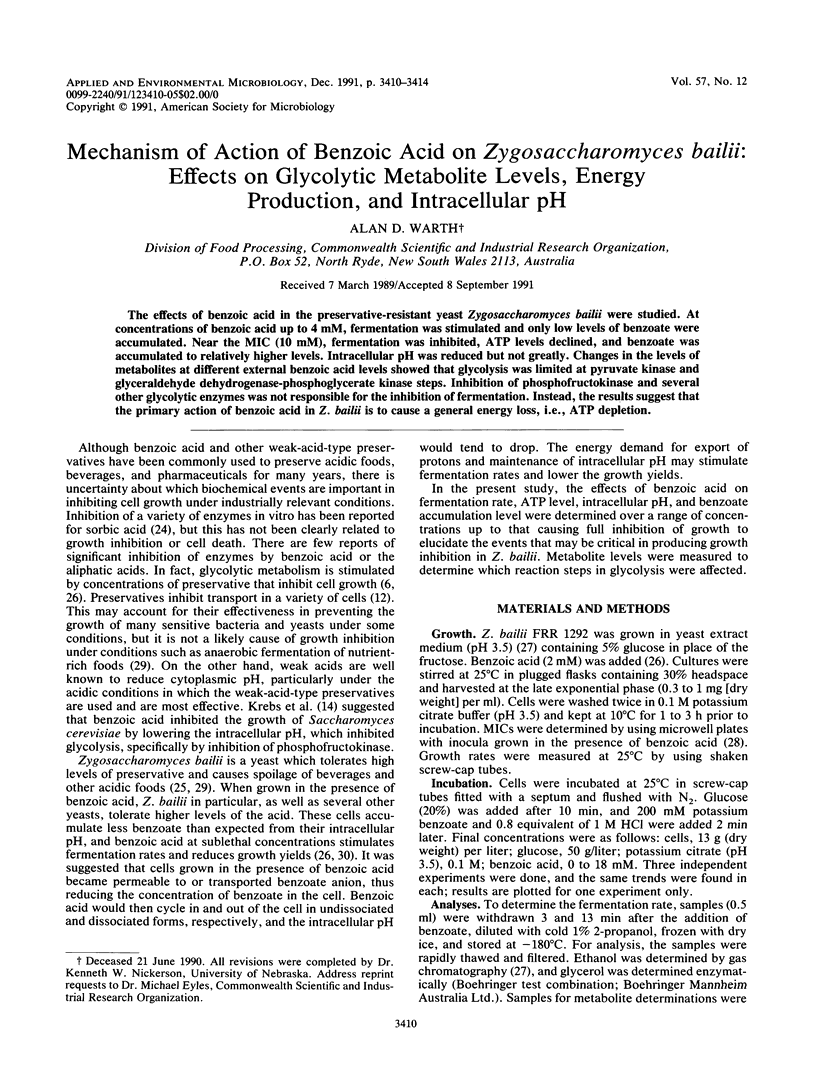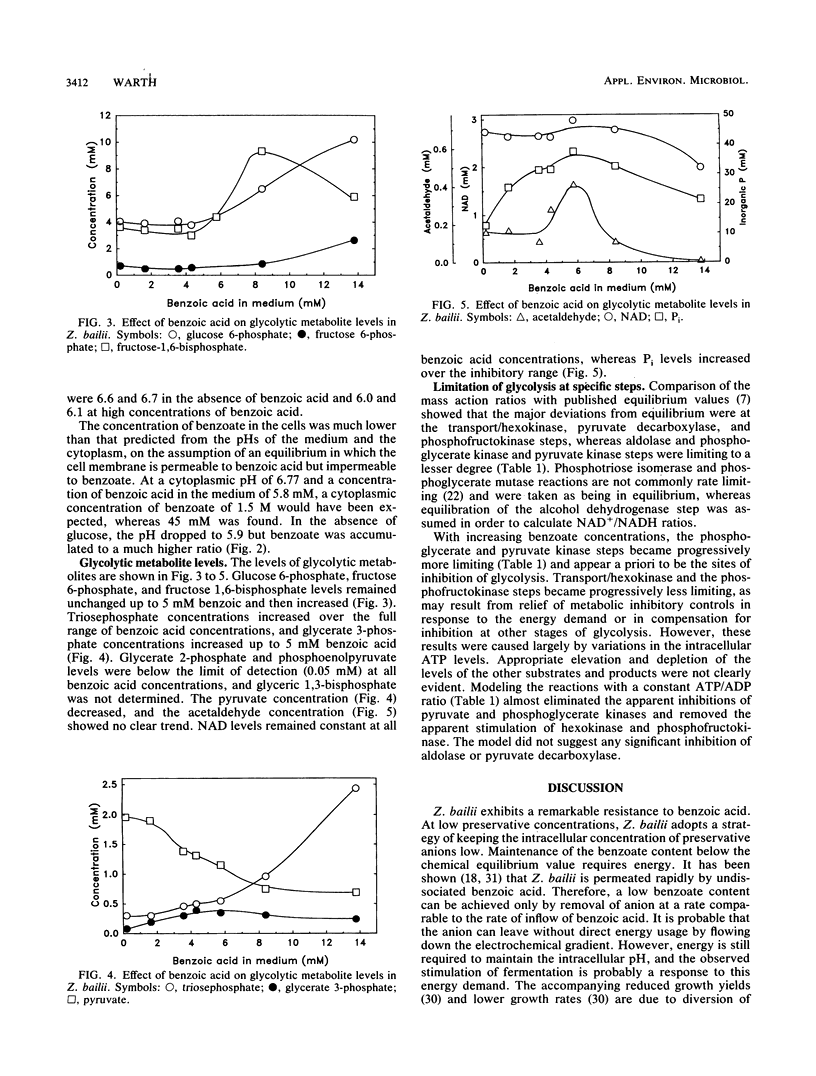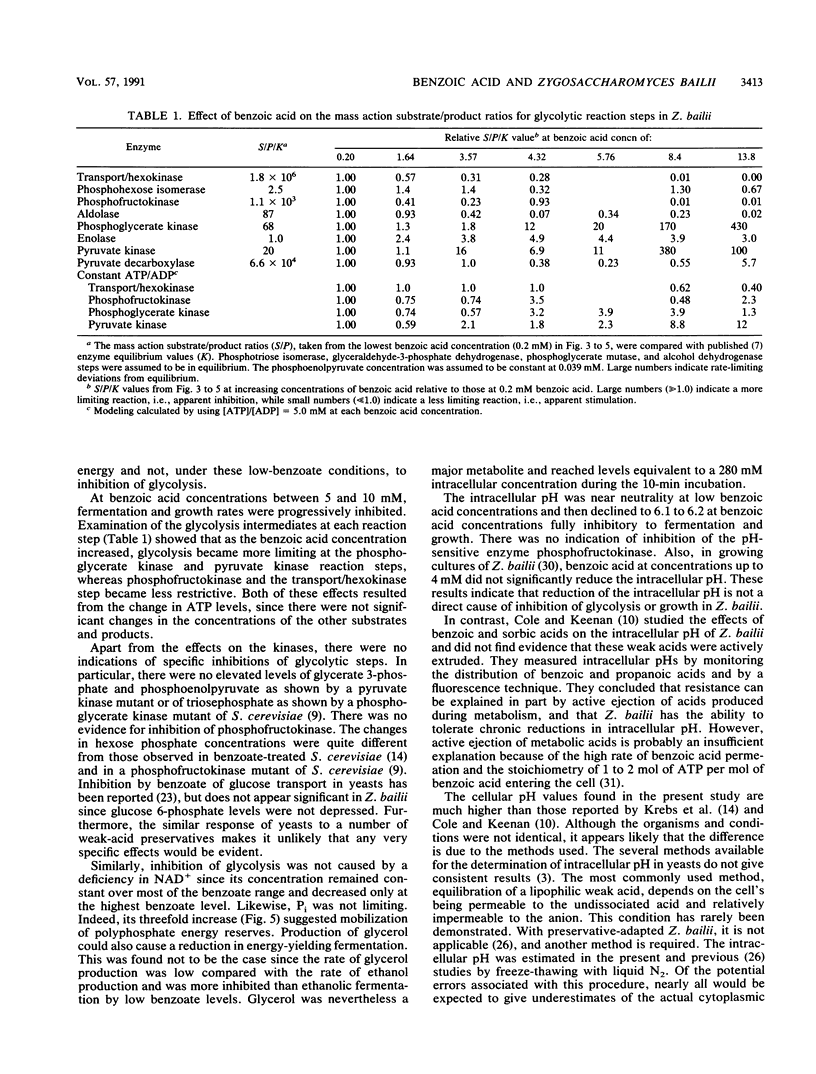Abstract
The effects of benzoic acid in the preservative-resistant yeast Zygosaccharomyces bailii were studied. At concentrations of benzoic acid up to 4 mM, fermentation was stimulated and only low levels of benzoate were accumulated. Near the MIC (10 mM), fermentation was inhibited, ATP levels declined, and benzoate was accumulated to relatively higher levels. Intracellular pH was reduced but not greatly. Changes in the levels of metabolites at different external benzoic acid levels showed that glycolysis was limited at pyruvate kinase and glyceraldehyde dehydrogenase-phosphoglycerate kinase steps. Inhibition of phosphofructokinase and several other glycolytic enzymes was not responsible for the inhibition of fermentation. Instead, the results suggest that the primary action of benzoic acid in Z. bailii is to cause a general energy loss, i.e., ATP depletion.
Full text
PDF




Selected References
These references are in PubMed. This may not be the complete list of references from this article.
- Ball W. J., Jr, Atkinson D. E. Adenylate energy charge in Saccharomyces cerevisiae during starvation. J Bacteriol. 1975 Mar;121(3):975–982. doi: 10.1128/jb.121.3.975-982.1975. [DOI] [PMC free article] [PubMed] [Google Scholar]
- Borst-Pauwels G. W. Ion transport in yeast. Biochim Biophys Acta. 1981 Dec;650(2-3):88–127. doi: 10.1016/0304-4157(81)90002-2. [DOI] [PubMed] [Google Scholar]
- Borst-Pauwels G. W., Peters P. H. Effect of the medium pH and the cell pH upon the kinetical parameters of phosphate uptake by yeast. Biochim Biophys Acta. 1977 May 2;466(3):488–495. doi: 10.1016/0005-2736(77)90341-8. [DOI] [PubMed] [Google Scholar]
- Ciriacy M., Breitenbach I. Physiological effects of seven different blocks in glycolysis in Saccharomyces cerevisiae. J Bacteriol. 1979 Jul;139(1):152–160. doi: 10.1128/jb.139.1.152-160.1979. [DOI] [PMC free article] [PubMed] [Google Scholar]
- Krebs H. A., Wiggins D., Stubbs M., Sols A., Bedoya F. Studies on the mechanism of the antifungal action of benzoate. Biochem J. 1983 Sep 15;214(3):657–663. doi: 10.1042/bj2140657. [DOI] [PMC free article] [PubMed] [Google Scholar]
- Macris B. J. Mechanism of benzoic acid uptake by Saccharomyces cerevisiae. Appl Microbiol. 1975 Oct;30(4):503–506. doi: 10.1128/am.30.4.503-506.1975. [DOI] [PMC free article] [PubMed] [Google Scholar]
- Navon G., Shulman R. G., Yamane T., Eccleshall T. R., Lam K. B., Baronofsky J. J., Marmur J. Phosphorus-31 nuclear magnetic resonance studies of wild-type and glycolytic pathway mutants of Saccharomyces cerevisiae. Biochemistry. 1979 Oct 16;18(21):4487–4499. doi: 10.1021/bi00588a006. [DOI] [PubMed] [Google Scholar]
- Scharff T. G., Badr M. Z., Doyle R. J. The nature of salicylate inhibition of sugar transport in yeast. Fundam Appl Toxicol. 1982 Jul-Aug;2(4):168–172. doi: 10.1016/s0272-0590(82)80041-9. [DOI] [PubMed] [Google Scholar]
- Warth A. D. Effect of benzoic Acid on growth yield of yeasts differing in their resistance to preservatives. Appl Environ Microbiol. 1988 Aug;54(8):2091–2095. doi: 10.1128/aem.54.8.2091-2095.1988. [DOI] [PMC free article] [PubMed] [Google Scholar]


